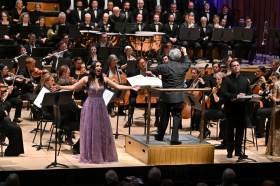“From our point of view, this isn’t a ‘pop’ exhibition,” says V&A spokesperson Meera Hindocha. “It is a fun exhibition, aimed at a younger audience, but it draws on the themes of fashion, style, contemporary culture, performance and the creation of a contemporary, popular icon. The V&A is a museum of design and these ideas and concepts all draw on the V&A’s permanent collection.”
She’s talking about the V&A’s recent crowd-pleaser, Kylie: The Exhibition, which traces the career of the Aussie pop princess through an in-depth look at her outfits: the gold lame hotpants which she bought for 50p and wore triumphantly in the video for Spinning Around, spawning a slightly unhealthy national obsession with her bottom; the dungarees she donned to play the much-adored Charlene in Neighbours; a spectacular gown designed by X, adorned with pictures of her own face. The cult of celebrity is one of our defining modern obsessions, and museums like the V&A, with their history of cultural analysis, seem perfectly placed to analyse it. Why, then, has the Kylie exhibition ruffled so many critical feathers?
Some critics have argued it’s because the exhibition simply doesn’t delve deeply enough into the meaning of Kylie. “Taking place in the V&A, you expect a scholarly examination of Kylie’s cultural and artistic significance, her clothes to be enshrined in glass cases, gently shimmering under spotlights, their meaning explored in lengthy essays about post-modernism and the cult of celebrity,” writes Bernadette McNulty in the Telegraph. “So it’s a shock to find it more akin to walking into the kind of unbranded ladies’ boutique that caters for dancehall divas looking for something Lycra, sequined and barely there to wind the night away in.” Still, she gave the exhibition a tentative thumbs up, as did commentators in other newspapers. In fact, the overall critical response to the exhibition has been one of mild bemusement – a Kylie exhibition? – twinned with grudging enjoyment. Pretty dresses are nice to look at, after all.
The public response speaks for itself. Coming at the height of the tabloid fixation with Kylie’s bout of breast cancer – the poor brave thing! – and her break-up with French actor Olivier Martinez – the ungrateful bastard! – the exhibition has attracted droves of visitors. “We have had over 80,000 people through the doors since it opened,” says Hindocha. “However, as we have never previously had a free but ticketed display at the V&A it is hard to draw direct comparisons to previous exhibition attendance here. We haven’t yet received conclusive research on the types of visitors the exhibition has, but anecdotally, we have found that the audience has been very varied, and the exhibition has attracted a number of first time visitors to the V&A.”
Kevin Moore, director of Preston’s National Football Museum and author of the book Museums and Popular Culture, argues that this is one of the key roles played by popular culture exhibitions. “People come to our museum who wouldn’t normally got to museums. We get twice the national average of people from C2DE backgrounds. I think it breaks down the code and interests people in museums. We have kids coming on school groups and they come back with their parents. Their parents might think that museums are stuffy, elitist, not for them, but I think we do lead people to see things differently.”
He believes that critics of pop culture exhibitions have missed the point – exhibitions are explorations of a subject, rather than value judgments. “I don’t see a problem with it because you’re not saying it’s just as good, you’re not having to value it and say football is art. It’s socially incredibly significant, it’s the world’s number one sport, so simply because of its existence and popularity it needs to be explored. We’re not a celebration of football, we’re a proper research museum. We look at the good and the bad: the disasters, the hooliganism, the corruption in the game. It has an educational purpose. As long as you’re treating the subject matter seriously then what’s the problem?”
The V&A’s Kylie: The Exhibition doesn’t make such high claims for itself. Hindocha says, “It offers a unique opportunity to take a closer look at the designing, styling and preparation that takes place behind the scenes of an international tour of an icon like Kylie as well as the chance to see work by some of the world’s greatest fashion designers including John Galliano and Karl Lagerfeld.” It sounds a bit flimsy, but if you squint, you can begin to see Kylie as less a human being and more a cultural industry, like Wedgewood china or Victorian cameos. As such, her place in the V&A seems a natural step.
Over at the National Portrait Gallery, another celebrity icon, Kate Moss, is currently on display. A new portrait by Corinne Day is the centrepiece of the Face of Fashion exhibition, and paparazzi photographers dutifully turned up to snap Moss trotting into the gallery, her drug-addled boyfriend on her arm. The circularity and complexity of the current relationship between celebrity, pop culture, image and identity will probably have to be left for still-unborn historians to pick over, but Day’s portraits of Moss (the exhibition contains several) are fair game for an art gallery: painters and photographers have been depicting beautiful people since antiquity. And the pleasure of looking at a beautiful representation of a beautiful body somehow feels like it goes deeper than a mild aesthetic buzz. Asked about his new actress-muse Scarlett Johanssen, Woody Allen adapted a line from his film Manhattan: “Scarlett is God’s answer to Job. God would say, ‘I’ve created a terrifying and horrible universe, but I can also make one of these, so stop complaining.’” In a world that frequently seems terrifying and horrible, perhaps the odd celebration of mindless beauty, pleasure and pop in high places might do us all some good.



